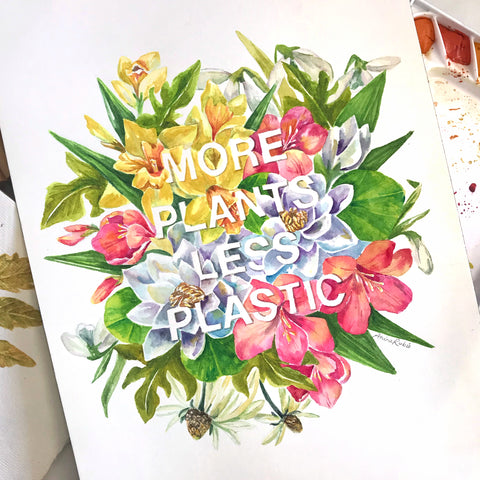Art and Conservation
Artist Anina Rudio began advocating for the environment because of an open water swim. At the time, Rubio, who grew up in the city, was taking it upon herself to explore different parts of the country.
“I saved enough money every month or so to explore different areas in the Philippines,” Rubio shares. “This meant going on island hopping trips and being by the sea.”
At the start of her series of trips, Rubio actually feared open water. But she eventually conquered the fear, daring to take off her life jacket.
“I pushed myself to take a leap of faith and learned how to swim,” says the artist. “Instead of being welcomed by fishes, I was welcomed by floating debris of plastic trash–straws, bottles, wrappers, and even diapers.”
What followed the experience was an awakening. She realized the grim reality that the seas and the environment face. “Once you experience it first-hand then it changes your perspective on things,” Rubio explains. It was then she understood that nature had a message to be shared, and that she would do her part by sharing this message.
Art to communicate
As an artist, Rubio knew that art can become a tool for communication, a powerful one at that. She decided she could use her profession to help the planet. To supplement her art and commit to her cause, Rubio took short courses on oceanography, the Sustainable Development Goals, and marine litter. Afterall, whatever the mode of communication, it’s essential to share facts, especially in such a scientific issue.
“Environmental art, for me, bridges the gap between conservation and humans,” shares the artist. “ It makes conservation matters more relatable and easier to understand, and of course, visually stimulating.”

A mural of Rubio’s that advocates for whale shark conservation. Image courtesy of Anina Rubio
And no matter what type of art a viewer prefers, Rubio’s work will most likely communicate effectively, as her artistic skill set is large. She is a calligrapher, painter, muralist, and textile artist–all at once. To spread her message, she is able to use words, colors, shapes, and material.

Image courtesy of Anina Rubino
The last of which, material, was a focal point for her Agua Caja Installation. Rubio created it for Fashion Revolution, a global movement for sustainable fashion. The installation conveyed the message of the impact of fashion on oceans, and it used textile as the main material.
“ I was invited to join the project as a muralist, actually, but after attending the 3-day workshop on sustainable fashion, circularity, and more, I knew I had to use textile instead of paint for my installation,” shares the artist.
Along with scrap fabric, she also used locally sourced bamboo, which due to its naturally renewable properties, is known to be a sustainable building material.
To Rubio, art is not always merely about aesthetics. The tools and materials used in art-making also have an impact on the environment. Using the right ones sends a message: art can be both beautiful and purposeful.

The Agua Caja Installation is one of Rubio’s favorite works. Image Courtesy of Anina Rubio.
When asked about her current and future work, Rubio shares that she is actively creating Cajas. Scrolling through her site, one can find many photos of these, as they’re regularly commissioned. Alongside this, she is working on digital projects in the form of an e-book and a marine conservation-themed mural in a basketball court.
Past or future, you’ll find that one thing rings true in most of her work. Whether through material, words, or visuals, Rubio’s message and inspiration is clear. She’s committed to the cause she took up in 2013, back when she dared to swim in the open water.
By Danielle Ramos
